The fifth TARTLE exhibition – Vilnius Forever. A Dialogue of Artworks and Guides to the City
The fifth exhibition of the Lithuanian Art Centre TARTLE has been prepared in cooperation with the YIVO Institute for Jewish Research in New York City and is dedicated to the 700th anniversary of Vilnius.
The Lithuanian Art Centre TARTLE boasts not only a rich collection of artworks on the theme of Vilnius, but also a large number of publications about Vilnius and historical guidebooks to the city. These two collections are presented in the exhibition ‘Vilnius Forever. A Dialogue of Artworks and Guides to the City’ covering the period of the second half of the 19th and the 20th century.
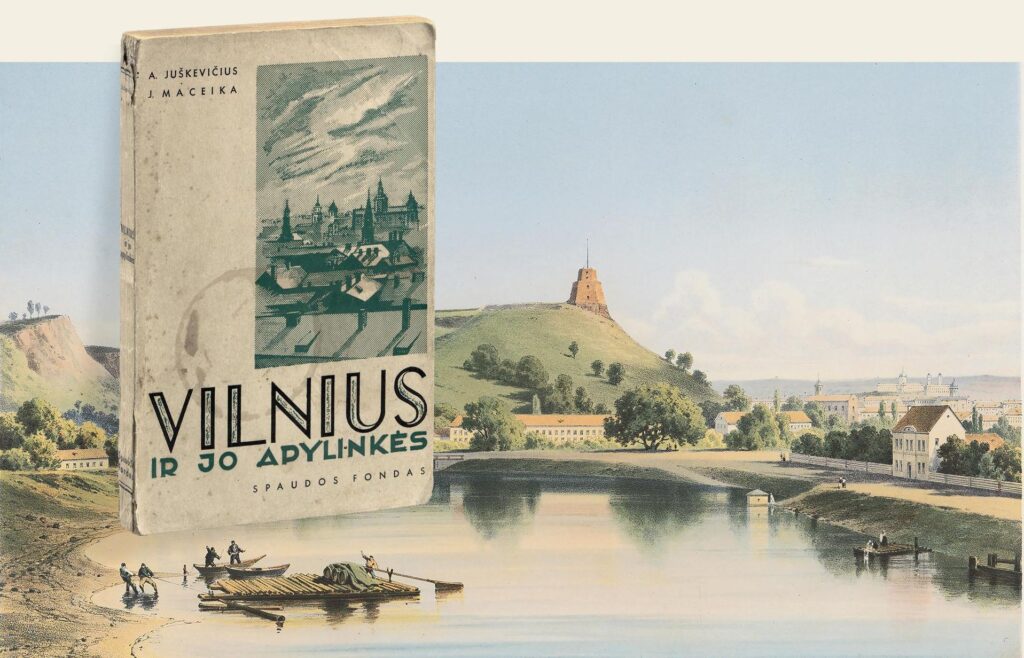
The Vilnius theme has never lost its popularity, guidebooks went through many reprints, and views of the city were multiplied as art prints. The exhibition presents twenty-six guidebooks written by such prominent authors as Adam Honory Kirkor, Władysław Zahorski, Juljusz Kłos, Zalmen Szyk or Mikalojus Vorobjovas. The chronologically divided exhibition reflects the variety of Vilnius cultures and languages: the initial rooms showcase Polish and Russian guidebooks of the second half of the 19th century, the largest room presents Polish and German guidebooks of the early 20th century and the interwar period, and the rest of the exhibition contains guidebooks published in Yiddish and Lithuanian before the war and in the Soviet period. Along with the books, contemporaneous artworks are exhibited: guidebooks informed the readers about the city’s top attractions, and artists represented them in series of graphic art. The repertory of places of interest travelled from book to book and from work to work, thus consolidating the register of the city’s ‘eternal’ values. More than 100 prints from thirteen series dedicated to Vilnius, postcards and approximately two dozen drawings and paintings are showcased in the exhibition. Among the authors are Mstislav Dobuzhinsky, Jerzy Hoppen, Adam Międzybłocki, Petras Repšys and others.
The first guidebooks of Vilnius appeared soon after their predecessors began to be published in Europe in the 1830s. Publications by the German publisher Karl Baedeker, who developed their content and structure, became widely popular to the extent that guidebooks came to be generically called ‘Baedekers’. They presented geographical, historical and cultural information, descriptions of places of interest and itineraries, gave practical information about transport and accommodation and included a map. Vilnius guidebooks were based on the same principles.
The TARTLE exhibition for the first time presents the history of Vilnius guidebooks, showcases the works by the artists Ber Zalkind and Alfred Holler, and introduces the interwar American artist Lionel Reiss, whose Vilnius-related works have been lent to the exhibition by the YIVO Institute for Jewish Research in New York City. Several exhibits are courtesy of the Martynas Mažvydas National Library of Lithuania, Tanya Rubinstein-Horowitz and Laima Laučkaitė.
Curator – Laima Laučkaitė
Architects – Jurgis Dagelis and Justinas Dūdėnas
Graphic designer – Juozapas Švelnys
Photo credits – Andrius Stepankevičius, Antanas Lukšėnas
Project is financed by Lithuanian Council for Culture
![]()
read more
The pioneer
The publisher, archaeologist and historian Adam Honory Kirkor (1818–1888) published the first guide to the city, titled Walks Around Vilnius and Its Environs, in Polish (1856). He wrote: “We see how passionate Lithuanians are about their capital and their monuments, which have close ties to almost every Lithuanian family. Our main goal was to overview all the noteworthy monuments in a small booklet and comment on their historical circumstances […].” Eighteen walks along the city’s streets familiarize the reader with churches, important buildings, parks, etc.
Adam Honory Kirkor (1818–1888)
Przechadzki po Wilnie i jego okolicach / Walks Around Vilnius and Its Environs
Vilnius, 1856
Kirkor’s guide Vilnius and the Railway from Vilnius to Saint Petersburg, Riga and Towards the Border in the Direction of Kaunas and Warsaw was published in 1862. The railway line Vilnius-Daugavpils built in 1860 brought a new era of modernity and tourism, and changed the city guide’s narrative. The guide starts with the railway information, followed by the city’s history, statistics, and an acquaintance with its suburbs, parishes and streets. The city’s administration, finances, industry and commerce are briefly described. Finally, some information is given about various churches (both active and closed), cemeteries, welfare and educational institutions, and the city’s environs. It is a kind of encyclopaedia of Vilnius.
Adam Honory Kirkor (1818–1888)
Przewodnik. Wilno i koleje żelazne z Wilna do Petersburga i Rygi, oraz do granic na Kowno i Warszawę / A Guide. Vilnius and the Railway from Vilnius to Saint Petersburg, Riga and Towards the Border in the Direction of Kaunas and Warsaw
Vilnius, 1862
Adam Honory Kirkor (1818–1888)
Przewodnik po Wilnie i jego okolicach z wykazaniem historycznym najbliższych stacyi kolei żelaznych / A Guide to Vilnius and Its Environs with a Historical Overview of the Nearest Railway Stations
Vilnius, 1889
Views of the exposition
The most valuable monument of 19th century Lithuanian graphic art – The Vilnius Album (Album de Wilna) – was published by Jan Kazimierz Wilczyński (1806–1885), a physician and art lover. Paintings that he commissioned from Lithuanian artists were lithographed for The Vilnius Album by Parisian lithographers between 1842 and 1858. The lithographs represent historical themes and portraits of prominent figures, with Vilnius monuments occupying the central place.
Views of the exposition
The album was instrumental in drawing up a list of the city’s major religious and art objects: The Gate of Dawn, the miraculous painting of Our Lady of the Gate of Dawn, the Cathedral, the Town Hall, baroque churches (among them the Missionary Church and St Raphael’s Church, which were closed after the uprising), and the suburbs with residences, as well as the pride of Vilnius – the Museum of Antiquities maintained by the Vilnius Archaeological Commission, whose members were Wilczyński and Kirkor.
Jan Kazimierz Wilczyński (1806–1885)
Album de Wilna / Album of Vilnius
1845–1858
The Russian view
After the uprising against tsarist Russia in 1863, repressions were launched, and many Catholic churches were closed. The tsarist authorities initiated the policy of “restoring the Russian origins” in the North-Western Krai (as Lithuania was called at that time). In tourist guides Vilnius was presented as a city with Slavic roots and history.
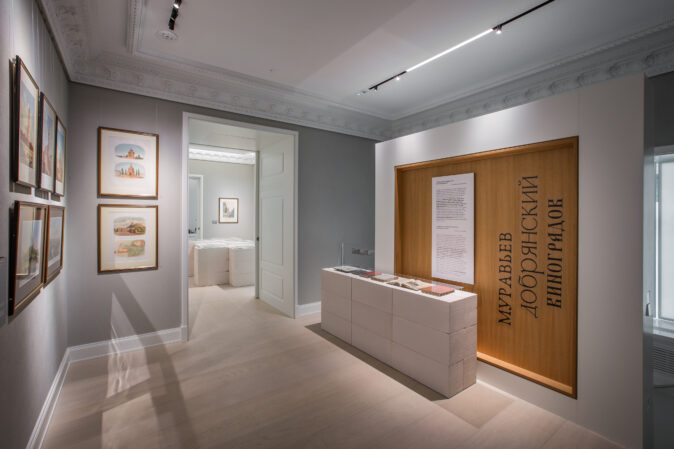
View of the exposition
In 1865, The Russian Vilnius dedicated to Eastern Orthodox holy places came out; it was written by Andrey Muravyov (1806–1874), the brother of Mikhail Muravyov who orchestrated the suppressing of the uprising of 1863. Flavian Dobryansky (1848–1919), an alumnus of the Moscow Eastern Orthodox Theological Academy and a member of the Commissions of the Public Library and Archaeography, wrote the guide The Old and New Vilnius (1883). It showed an obvious hierarchy of the gaze: a historical overview was followed by a presentation of Eastern Orthodox churches and then sanctuaries of other religious denominations. Cemeteries, monuments, places of interest, academic and welfare organisations, and societies were presented accordingly. A Guide to Vilnius and Its Environs by Alexander Vinogradov (1904) had a similar structure and approach. It was the first Vilnius guide illustrated with photographs.
Андрей Николаевич Муравьев / Andrey Muravyov (1806–1874)
Русская Вильна / Russian Vilnius
Vilnius, 1865
Флавиан Николаевич Добрянский / Flavian Dobryansky (1848–1919)
Путеводитель по Вильне и ея окрестностям / A Guide to Vilnius and Its Environs
Vilnius, 1890
Флавиан Николаевич Добрянский / Flavian Dobryansky (1848–1919)
Старая и новая Вильна / The Old and New Vilnius
Vilnius, 1904
Александр Александрович Виноградов / Alexander Vinogradov (1883–1928)
Путеводитель по городу Вильне и его окресностям / A Guide to the City of Vilnius and Its Environs
Vilnius, 1904; 1908
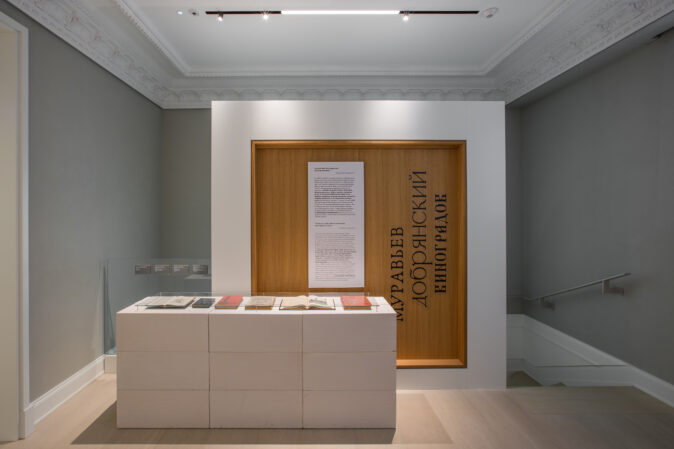
View of the exposition
The policy of “restoring the Russian origins” was promoted by the patron of the Vilnius Educational District, Pompey Batyushkov (1811–1892). He was involved in archaeology, ethnography and history, and published books, the most important of which was the album Old Russian Monuments in the Western Provinces. Drawings for the album were created by local Russian artists, and lithographs were printed in Berlin in 1865–1886. The album depicted Vilnius as an Eastern Orthodox city. Among the images are Eastern Orthodox churches, newly built or converted from Catholic, and the ruins of the Higher Castle, which, according to Batyushkov, bore witness to the times when Lithuanian rulers were expanding their domains into the Slavic lands and building family ties with Russian dukes. Tsarist ideologists praised this period of the “Lithuanian-Russian state”, which ended in 1384, when Jogaila married Jadwiga and Lithuania changed its orientation from Russian/Eastern Orthodox to Polish/Catholic.
Помпей Николаевич Батюшков / Pompey Batyushkov (1811–1892)
Памятники русской старины северо-западного края / Old Russian Monuments in the Western Provinces
1874
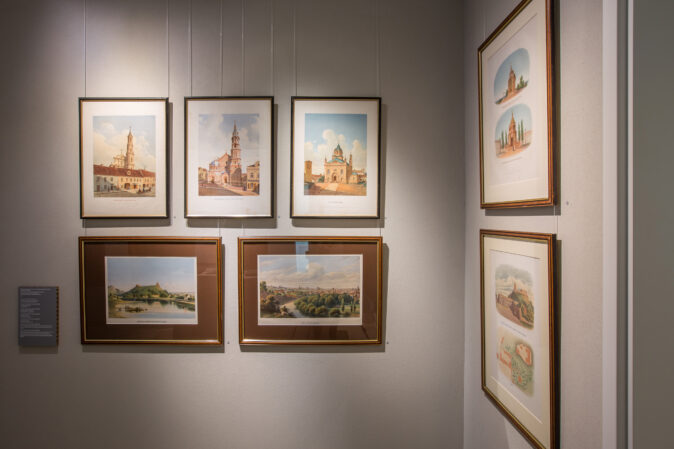
View of the exposition
The Polish view
After the liberalization of the Russian Empire in 1905, the new Polish guides to the city began to be published. One of them, which came out in 1910, was written by Władysław Zahorski (1858–1927), a physician and an amateur historian who headed the Vilnius Society of Friends of Science. This guide contained general tourist information (with tips for visits of various duration), an overview of the city’s history, an acquaintance with its streets, significant buildings, churches, cemeteries and environs. The guide was illustrated with photographs by Jan Bułhak, which since then flooded all guides.
Władysław Zahorski (1858–1927)
Przewodnik po Wilnie / A Guide to Vilnius
Vilnius, 1910; 1921; 1923; 1927; 1935
In 1910, A Guide to Vilnius was published by Wacław Gizbert-Studnicki (1874–1962), a journalist, the head of the City’s Archive, and a political figure of the Polish National Democracy movement. The text presents general information about the city and its history, and offers several itineraries around the Old Town as well as outings to the suburbs and environs. The early 20th century is the period of ethnic division in society and the separation of peasant/Lithuanian and noble/Polish identities, which gave rise to nationalism. Since that time, Polish guides represented Vilnius as a Polish city (allegedly it was Lithuanian only in the pagan times, and later Polish culture became predominant). Both guides contained a list of Russian and Polish street names.
Wacław Gizbert-Studnicki (1874–1962)
Wilno: przewodnik ilustrowany po mieście i okolicach z planem miasta i dodatkami / An Illustrated Guide to Vilnius and Its Environs with a City Plan and Annexes
Vilnius, 1910
Wacław Gizbert-Studnicki (1874–1962)
Wilno: przewodnik po mieście i okolicach / Vilnius: A Guide to the City and Its Environs
Vilnius, 1919
Wacław Gizbert-Studnicki (1874–1962)
Wilno: przewodnik / Vilnius: A Guide
Vilnius, 1921
At the time when Władysław Zahorski and Wacław Gizbert-Studnicki published their guides, Mstislav Dobuzhinsky (1875–1957) created drawings of Vilnius. A descendant of nobles of the Grand Duchy of Lithuania, the artist grew up in Vilnius and after his studies at the Saint Petersburg Academy of Arts remained in Saint Petersburg and joined the ranks of Russian Silver Age artists and the World of Art movement. Dobuzhinsky won fame as a poet of the old city and a master of art noveau-style drawing. During his visits to Vilnius to see his parents, he drew views of the city. Rather than iconic monuments, in his drawings he depicted the city’s cosy nooks and corners, old courtyards, Stiklių and Mėsinių streets with colourful street signs. In the early 20th century, the Society of St Eugenia in Saint Petersburg published a series of Vilnius views by Dobuzhinsky. The artist continued to work on this series in the years of World War I.
Postcards of Vilnius with images of Mstislav Dobuzhinsky’s (1801–1866) paintings
Saint Petersburg, ca. 1913
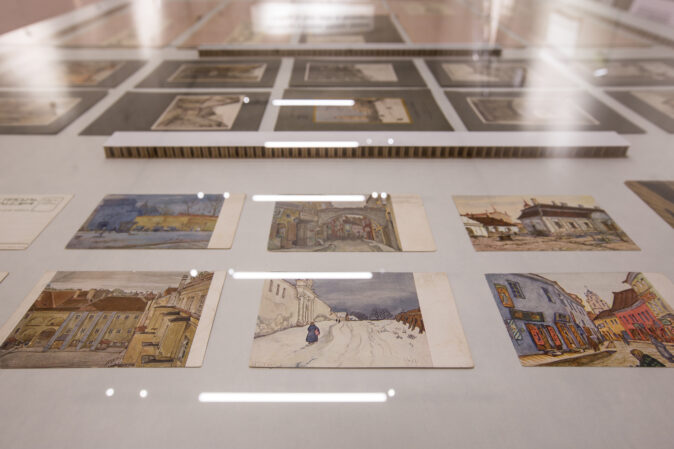
View of the exposition
The German view
In the years of World War I, the Press Department of the German army published propaganda literature about the residents of the occupied country, its history and culture. In 1916, the Berlin art critic and theoretician of expressionism Paul Fechter (1880–1958) and the theatre critic Monty Jacobs (1875–1945) published the book Wandering Hours in Vilnius under the pseudonym PAUL MONTY. Referring to the city plan as chaotic, the authors of the guide invited randomly walking along the streets, discovering Christian temples and Jewish neighbourhoods, and from the Old Town wandering to the suburbs and environs. The vividly written guide is brimming with emotional impressions.
Paul Monty
Wanderstunden in Wilna / Wandering Hours in Vilnius
Vilnius, 1916
In 1917, the guide titled Vilnius, a Forgotten City of Art was published. Its author was professor Paul Weber (1868–1930), the head of the Jena City Museum. Appointed a conservator of Lithuanian cultural monuments, he worked in Vilnius between 1916 and 1918. Based on the periodisation of the city’s history, Weber presented the development of architectural styles from Gothic to Classicism through monuments. It was the first view of Vilnius from a professional art historian.
Paul Weber (1868–1930)
Wilna eine vergessene Kunststätte / Vilnius, a Forgotten City of Art
Vilnius, 1917
In the years of World War I, along with the German army, German artists arrived in the city. Vilnius became an unexpected discovery and a source of inspiration for them. Alfred Holler (1888–1954) after his studies at the Art Academies of Düsseldorf and Karlsruhe came to Vilnius as a war artist. He captured some locations of the city that later disappeared; not being aware of iconic views, he found unexpected angles and was fascinated with the Jewish quarter. Like Paul Monty, Holler had an emotional and subjective view of the Old Town and was enchanted with the winter element in the city. In 1917, his drawings were published in a separate album titled Vilnius. 12 colour images printed in Magdeburg.
Alfred Holler / Alfredas Holleris (1888–1954)
Wilna. 12 Farbige Bilder / Vilnius. 12 spalvotų vaizdų / Vilnius. 12 colour images
1917
A graduate of the School of the Berlin Museum of Decorative Arts, Walter Buhe (1882–1958), worked in the Wilnaer Zeitung newspaper. He was fascinated with street scenes and drew hundreds of episodes of daily life of the residents of Vilnius. Tinted with soft humour, his drawings were published in the Christmas albums of the Wilnaer Zeitung in 1916 and 1917.
Walter Buhe (1882–1958)
Wilna im Kriegsjahr 1916 / Vilnius in the Year of War 1916
Professionals at work
After the Great War and the struggle for Vilnius, in 1922, the city became part of Poland. Guides of the interwar period are characterized by two features: they were written by professional art historians rather than amateurs, and Vilnius was seen as a Polish city. In 1923, Vilnius. A Local Lore Guide by Juljusz Kłos (1881–1933) was published. Kłos studied architecture in Warsaw and Vienna, and from 1920, he taught the history of architecture at Stephen Báthory University and was involved in the restoration of churches and university buildings closed in the tsarist times. His guide consisted of three parts: an overview of the city’s history, the stylistic development of architecture, and a presentation of topographically arranged objects. Kłos’s text was based on an architectural analysis and had a strong emotional colouring: “As we explore Vilnius and get carried away by the beauty of its legend, we find out that getting to know Vilnius means falling in love with it forever.”
Juljusz Kłos (1881–1933)
Wilno. Przewodnik krajoznawczy / Vilnius. A Local Lore Guide
Vilnius, 1923; 1929; 1937
Jerzy Hoppen (1891–1969) moved to Vilnius in 1921 to study art in Stephen Báthory University and lectured there from 1931. He won fame as a graphic artist who fell in love with the Old Town of Vilnius. Hoppen was well familiar with its architectural monuments as he took part in their conservation together with Juljusz Kłos. In 1924–1927, he created a series of etchings ‘Old Vilnius’, whose stylistics was reminiscent of the works of old masters. The shapes of Vilnius baroque architecture and their magnificence are conveyed precisely and sensitively. Making use of chiaroscuro effects, stormy baroque clouds and scenes with figures from the past, Hoppen added an aura of the past to the city’s views.
Jerzy Hoppen (1891–1969)
Series of etchings ‘Old Vilnius’
1924–1927
The author of the most beautiful guide to Vilnius of the interwar period was Jerzy Remer (1888–1979). He studied art history at the University of Kraków, and attended courses in museology and monument protection at the Louvre Museum. Between 1922 and 1928, he worked as a monument conservator of the Vilnius Voivodeship, lectured at Stephen Báthory University, and later became the chief monument conservator of Poland. Inspired by his impressions in Vilnius, he wrote the book Vilnius, a guide to the city of art. The book came out in the series “The Miracles of Poland” published in Poznań in 1934 and distinguished by its contemporary design. Remer revealed how the city evolved from the pagan period until his times through works of architecture and art, and also showed the cultural context. He created a dynamic narrative of the history of Vilnius art marked by periods of flourishing and decline, dramatic twists and turns.
Jerzy Remer (1888–1979)
Wilno
Poznan, 1934
In April 1919, Polish legionaries recaptured Vilnius from the Red army that had seized it and themselves took control of the city. Among them was Ignacy Pinkas (1888–1935), a legionary artist from Kraków who studied in Kraków and Paris. In 1929, he created a series of lithographs ‘Vilnius’, dedicated to commemorate the tenth anniversary of the victory against the Bolsheviks. Thus, his Old City is joyful and brimming with light and colours. The author of the foreword to the series, art historian Marian Morelowski (1884–1963), wrote that Vilnius was “a city that awakens powerful spiritual memories and is steeped in the beauty of lines and architectural silhouettes, undying ideas and courageous deeds.”
Ignacy Pinkas (1888–1935)
Wilno w avtolitografjach barwnych Ignacego Pinkasa / Series ‘Vilnius in Ignacy Pinkas’ Colour Autolithographs’
1929
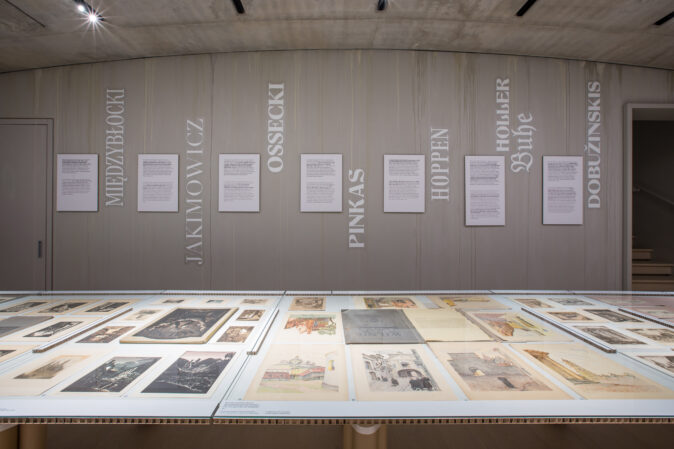
View of the exposition
In the interwar period, Vilnius attracted artists from all over Poland as a city of nostalgic beauty and a source of national mythology. In 1925, Wilhelm Ossecki (1892–1958), a graphic artist from Poznań, a graduate of the Kraków Academy of Art who studied art history at the Jagiellonian University, visited Vilnius. He greatly appreciated historical architecture and during his trips to France and Poland created works related to the theme of heritage. In Vilnius he visited the landmarks that came recommended by tourist guides, and created a collection of prints titled ‘Vilnius 1925’. He used different techniques, such as tinted wood engraving, etching and aquatint, for various objects to convey their different character.
Wilhelm Ossecki (1892–1958)
Wilno 1925 / Series ‘Vilnius 1925’
The art historian Marian Morelowski (1884–1963), after his studies in Kraków, Vienna and Paris, worked in the Commission for the Return of Valuable Polish Artworks from Russia and in the Wawel Museum in Kraków. In 1930–1939, he was the head and professor of the Department of Art History of Stephen Báthory University. He was a researcher of art history and the author of a comprehensive study A Guide to the Vilnius Environs in the Radius of 150 km (from the Neman to the Daugava) with a Synthetic Introductory Overview of Vilnius Art (1939). This work is still highly acclaimed by art historians.
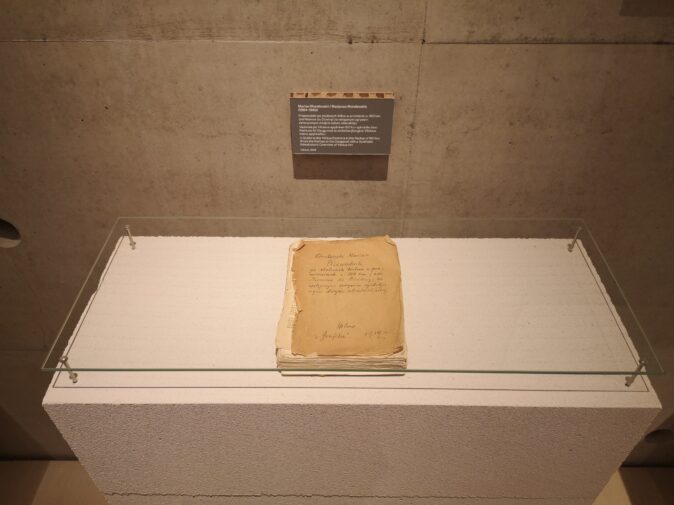
Marian Morelowski (1884–1963)
Przewodnik po okolicach Wilna w promieniu c. 150 km (od Niemna do Dzwiny) ze wstępnym ząrysem sytetycznym dziejow sztuki wilenskiej / A Guide to the Vilnius Environs in the Radius of 150 km (from the Neman to the Daugava) with a Synthetic Introductory Overview of Vilnius Art
Vilnius, 1939
In interwar Vilnius, a generation of young artists, alumni of the Art Department of Stephen Báthory University, came of age. Roman Jakimowicz (1899–1964) was one of the first artists to receive a diploma of this university in 1931. Still as a student, in 1925, he created a series of woodcarvings ‘Vilnius’. Just like Remer’s progressive and modern guide, Jakimowicz’s prints are distinguished by their modern form: simplified shapes, dramatic collisions of black and white patches. Jakimowicz was the first artist to present an expressionist vision of Vilnius monuments, which was later elaborated by his other colleagues. This vision is also vividly present in his series ‘Churches of Vilnius’ created in 1928 and dedicated to the lovers of Vilnius.
Roman Jakimowicz (1899–1964)
Wilno drzeworyty / Series of woodcuts ‘Vilnius’
1925
Roman Jakimowicz (1899–1964)
Kościoły wileńskie / Series of woodcuts ‘Churches of Vilnius’
1928
Vilnius in several hours
The history of Vilnius guides also reflects the major events in the city, which attracted crowds of visitors from Poland. Short illustrated guides were published for those occasions. On the occasion of the coronation festivities of the picture of Our Lady of the Gate of Dawn in 1927, as many as three guides for pilgrims were published: A Memento of Vilnius. My Guide by Piotr Sankowski, A Memento of Vilnius by Aleksandr Łętowski, and A Short Practical Guide to Vilnius by an anonymous author. In 1935, the year of Józef Piłsudski’s death, Vilnius in Several Hours written by the tourist guide Edward Kulwieć was published.
Piotr Sankowski
Pamiątka z Wilna. Mój przewodnik / A Memento of Vilnius. My Guide
Vilnius, 1927
Aleksander Łętowski
Pamiątka z Wilna / A Memento of Vilnius
Vilnius, 1927
Unknown author
Ilustrowany krótki praktyczny przewodnik po Wilnie / A Short Practical Illustrated Guide to Vilnius
Vilnius, 1927
Edward Kulwieć
Wilno w kilka godzin / Vilnius in Several Hours
Vilnius, 1935
Edvardas Kulvecas
Trumpas vadovas po Vilnių / A Short Guide to Vilnius
Vilnius, 1940
The burying of Józef Piłsudski’s heart and his mother’s remains in the Rasos cemetery in 1936 was a special event, and on that occasion A Short Guide. Vilnius and Its Environs by Kazimierz Lewkowicz came out. This publication was adapted for the visitors of popular annual events – “Northern Fairs” – presenting the industry, crafts and agriculture of the Vilnius region, and reprinted in 1937 and 1939.
Kazimierz Lewkowicz
Krótki przewodnik. Wilno i bliższe okolice / A Short Guide. Vilnius and Its Environs
Vilnius, 1938
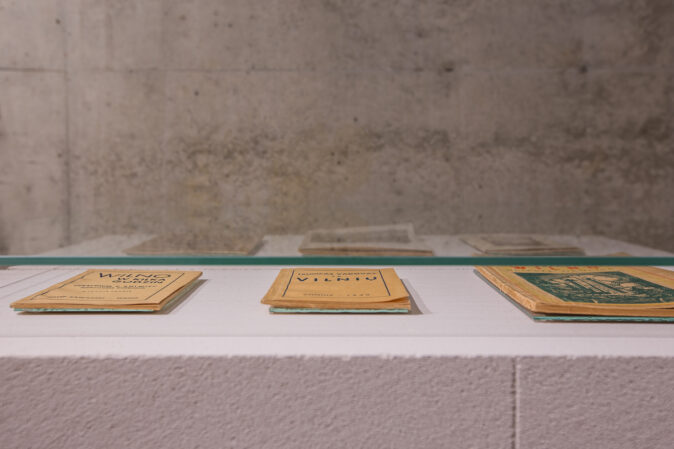
View of the exposition
The most popular interwar artist who used motifs of Vilnius in his work, Adam Międzybłocki (1883–1956), studied at the Vilnius Drawing School and the Kraków Academy of Art, lived in the Caucasus for a while, and returned to Vilnius in 1922. Cityscapes became the main genre of his work. Panoramic views, the buildings of Stephen Báthory University, memorial places of Adam Mickiewicz appealed to the residents of Vilnius, thus Międzybłocki represented them not once. His light, summery and cheerful paintings won the audience’s sympathy.
Adam Międzybłocki (1883–1956)
Views of Vilnius in watercolours
1920s–1930s
The Yiddish view
A Yiddish journalist, the chair of the Vilnius department of the Jewish Local Lore Society (Landkentenish), and Vilnius tourist guide Zalmen Szyk (?–1942) got an idea to publish a three-volume work A Thousand Years of Vilnius. He had time to publish only the first volume in 1939 – it was an illustrated guide to the city, introducing its past, its residents, streets, buildings, churches, squares, etc. Unlike ethnocentric Polish guides, Szyk spoke not only about the Jewish Vilnius, but also about the landmarks of the multi-national city. In the centre of his attention was the Shulhoyf (the courtyard of the Great Synagogue), the spiritual and physical centre of the Jerusalem of Lithuania, which was compared to a closed shtetl. Szyk described the Great Synagogue, the kloyzn located in the vicinity and elsewhere in the city (there were more than a hundred of them), emphasizing that their appearance did not differ from ordinary houses. He also offered a broader view of the modern city, and spoke about Jewish organisations of culture and science, the YIVO, education, medicine, and sport. Szyk’s narrative about Vilnius was influenced by Polish literature, and poetry quotes in Yiddish and Polish were used in the text.
זלמן שיק/Zalmen Szyk (?–1942)
/ יאָר ווילנע 1000
/ A Thousand Years of Vilnius
Vilnius, 1939
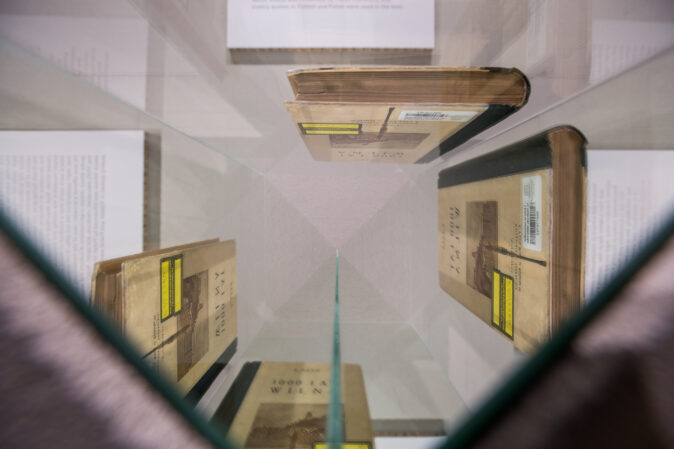
View of the exposition
A resident of Vilnius born and raised, Ber Zalkind (1879–1944), attended the Vilnius Drawing School, improved his professional skills in Paris, and in the interwar period taught art in Vilnius schools. Circa 1928, he published a collection of postcards ‘Vilnius Jewish Ghetto’ (Kunstvorlag publishers). Graphic drawings represent the Jewish religious and cultural centre described by Zalmen Szyk – the Great Synagogue and the Shulhoyf, courtyards with the kloyzn, Strashun’s library and adjacent streets. This neighbourhood was destroyed during the Second World War.
בר זלקינד / Ber Zalkind (1879–1944)
A collection of postcards ‘The Vilna Jewish Ghetto’
Ca. 1928
The Ukraine-born Lionel Reiss (1894–1988) saw this neighbourhood in a different way. Having moved to New York in his childhood, he created commercial graphics and animation for the Paramount studio. Circa 1920, he travelled to Europe and the Near East, capturing the views of old Jewish neighbourhoods. In Vilnius he created a series of colourful and bright views of iconic places vibrating with energy. These works have been lent to the exhibition by the YIVO Institute in New York City.
Lionel Reiss (1894–1987)
Views of Vilnius
Early 1920s
Collection of the YIVO Institute for Jewish Research in New York City
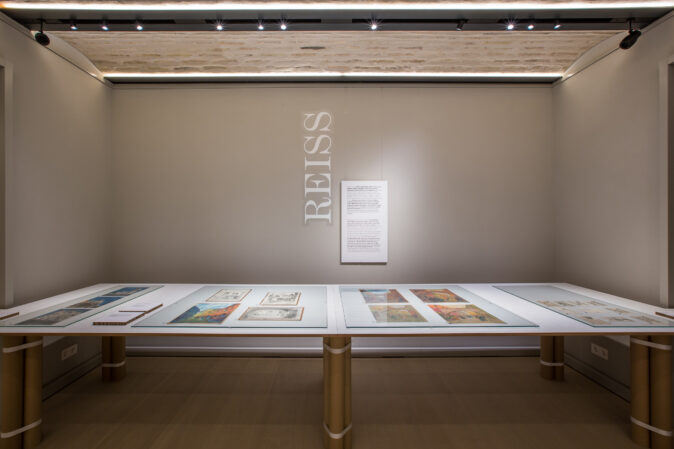
View of the exposition
Lithuanians discovering Vilnius
In the interwar period, Lithuanians were cut off from their historical capital and could learn about it only from the press. On the occasion of the city’s 600th anniversary, the album Vilnius 1323–1923 was published. The authors of the foreword were the leaders of the Keturi vėjai (Four Winds) movement, Kazys Binkis and Petras Tarulis.
Kazys Binkis (1893–1942), Petras Tarulis (1896–1980)
Vilnius 1323–1923
Kaunas, 1923
In 1937, Adomas Juškevičius (1905–1999) and Juozas Maceika (1904–1991) published the guide Vilnius and Its Environs. Both of them were graduates of Stephen Báthory University, Maceika worked as a tourist guide, and Juškevičius took part in the activity of the Lithuanian Scientific Society. The guide presents general information about the city and its short history, and separate chapters introduce its streets, notable buildings, prayer houses, cemeteries, and environs. The authors were keen on showing the Lithuanian character of Vilnius and places related to the national revival of the early 20th century. The Polish authorities confiscated the entire print run of the publication and filed a suit against its authors for disclosing military secrets (bridges).
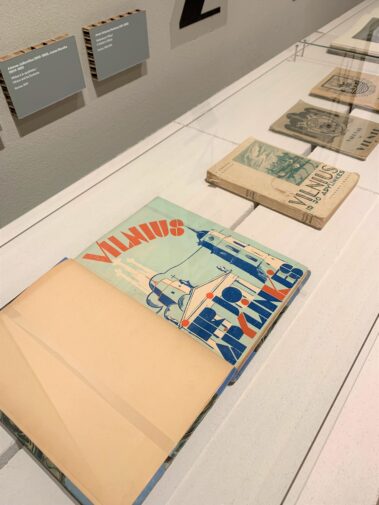
View of the exposition
Adomas Juškevičius (1905–1999), Juozas Maceika (1904–1991)
Vilnius ir jo apylinkės / Vilnius and Its Environs
Kaunas, 1940
In 1938, when Poland and Lithuania established diplomatic relations, tours to Vilnius began to be organized. The journalist Jonas Vytautas Narbutas (1911–1968) published a booklet titled A Guide Around Vilnius in 1939 in Kaunas. It contains a short presentation of the city, and a half of the text consists of a list of Lithuanian-Polish street names prepared by Mykolas Biržiška.
Jonas Vytautas Narbutas (1911–1968)
Vadovas po Vilnių / A Guide to Vilnius
Kaunas, 1938
Jonas Vytautas Narbutas (1911–1968)
Vadovas po Vilnių / A Guide to Vilnius
Kaunas, 1939
In the interwar period, Lithuania lived with the slogan “We will not rest without Vilnius”, but when Vilnius was returned to Lithuania, it turned out that Lithuanians were hardly familiar with the city. This gap was filled by several authors. In 1940, the book Art Monuments of Vilnius was published by Jonas Grinius (1902–1980), a graduate of the universities of Kaunas, Grenoble and Sorbonne, and a lecturer of Vytautas Magnus University. His guide was a kind of lecture on the architectural styles of Vilnius from Gothic to Neoclassicism, told through monuments.
Jonas Grinius (1902–1980)
Vilniaus meno paminklai / Vilnius Art Monuments
Kaunas, 1940
In 1940, The Art of Vilnius was published. The author of the book, Mikalojus Vorobjovas (1903–1954), after his studies in the universities of Marburg, Berlin and Munich, worked at a Kaunas bookshop. A talented storyteller, in his book he described the architectural styles of Vilnius from Gothic to Classicism, showing static architecture as a movement of forms and music in space, and conveying the change of its moods. Alongside, he sought to bring out the Lithuanian features of the city: “A panoramic view of Vilnius tells us that it is a city of Highland Lithuania, that the people who have been living there for many centuries vividly respond to the beauty of nature and architecture, and that its genius – as well as its ‘genius loci’ – is drawn to lyricism and romanticism.”
Mikalojus Vorobjovas (1903–1954)
Vilniaus menas / The Art of Vilnius
Kaunas, 1940
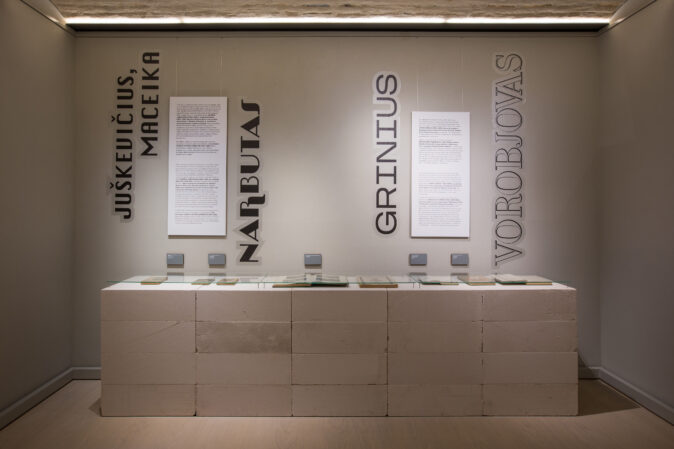
View of the exposition
In the interwar period, Vilnius was inaccessible to Lithuanian artists, and only symbolic signs of the city appeared in their works. When Vilnius was returned to Lithuania, in 1940, young artists invited to teach at the Vilnius Art Institute started to move to the capital. Among them was the printmaker Jonas Kuzminskis (1906–1985). Between 1942 and 1948, he created the series ‘Old Vilnius’. His images of the war years are distinguished by decorative stylization and magnificent panoramic views with church towers. In the Soviet period, Kuzminskis made an extraordinary career and became a people’s artist of the USSR. His works changed, images became dark, with smaller forms, ideologized: armed soldiers marching on the streets of the Old Town, flags with Stalin’s portraits hung above the entrance to the University. The Old Town of Vilnius in his works acquired a Soviet colouring.
Jonas Kuzminskis (1906–1985)
Series ‘Old Vilnius’
1942–1948
Mečislovas Bulaka (1907–1994) arrived in Vilnius from Kaunas in 1940, and after the war, for a short while worked as the head and a lecturer of the Vilnius Art Institute. He was fascinated with the Old Town, but did not represent its famous monuments. Bulaka made drawings of the Vilnius Ghetto immediately after its liquidation in September 1943: crumbling crooked buildings, dug out earth, heaps of bricks in bleak courtyards, lifeless streets. In postwar years he captured the ruins of the Great Synagogue. Bulaka’s album Vilnius Old Town. 24 sanguine drawings published in 1958 was adapted to suit Soviet and antisemitic ideology. In the foreword to the album, the historian Juozas Jurginis explained that the drawings depicted “the hellholes of working people” exploited by feudalists and capitalists, without mentioning that it was the Jewish Ghetto.
Mečislovas Bulaka (1907–1994)
The Old Town of Vilnius. 24 sanguine drawings
1958
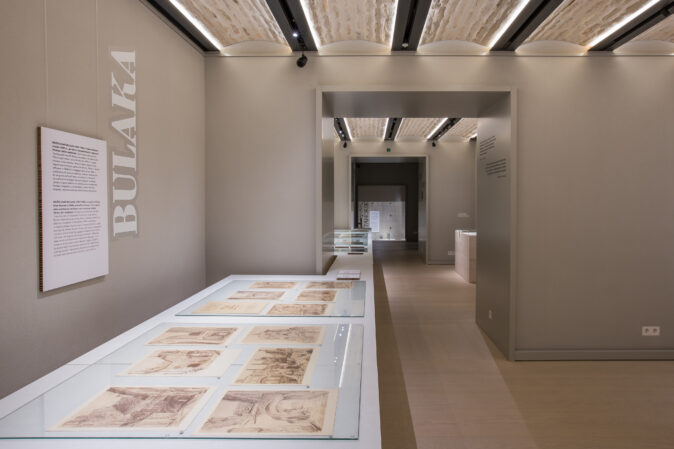
View of the exposition
The Soviet view
The history of Vilnius as the capital of the Grand Duchy of Lithuania posed an ideological threat to the Soviets, and in the period immediately following the war, no guides were published. In the 1950s, several brochures came out, and in 1960, A Guide to Vilnius written by the employee of the State Art Museum Juozas Maceika and the head of the same museum Pranas Gudynas (1919–1979) was published. The past and the present of Vilnius were shown from the perspective of the Communist party, a great deal of attention was given to Soviet figures and places of their activity, as well as the “achievements” of socialism. The authors took the reader to Vilnius streets and neighbourhoods, presenting not only revolutionary and Soviet locations, but also places of historical heritage, palaces and churches included in the list of architectural monuments of the Lithuanian SSR, and discussed their historical and artistic aspects. Full of ideological compromises, this guide is a fruit of Khruschev’s “thaw” and the period of liberalisation, and sheds more light on history and heritage. No more guides of similar scope were published in the Soviet period.
Juozas Maceika (1904–1991), Pranas Gudynas (1919–1979)
Vadovas po Vilnių / A Guide to Vilnius
Vilnius, 1960
Publications about Vilnius of the Brezhnev era were scanty, contained limited information and were heavily censored. The editor of the Mintis publishers, Arolfas Medonis (1931–1984), wrote the booklet About Vilnius for a Tourist (1965) and the brochure Vilnius (1966). The rich history of the city disappeared, being reduced to the struggle between the oppressors and the oppressed and revolutionary deeds. The propaganda text praises the changes brought about by socialism and the city’s growth; Lenin Avenue with its institutions is called the heart of the city. Architectural monuments are described formally, without their historical context, and the names of saints in the titles of churches are stripped of the abbreviation “St”.
Arolfas Medonis (1931–1984)
Turistui apie Vilnių / About Vilnius for a Tourist
Vilnius, 1965
Arolfas Medonis (1931–1984)
Vilnius
Vilnius, 1978
Arolfas Medonis (1931–1984)
Туристу о Вильнюсе / About Vilnius for a Tourist
Vilnius, 1965
Views of the exposition
Raised in Kaunas, Samuel Rozin (1926–2006) was imprisoned in the Kaunas Ghetto in 1941, escaped, made his way to the partisans, and after the war studied graphic art at the Leningrad Institute of Painting, Sculpture and Architecture. Upon his return, he created the series ‘Vilnius’ (1957). The series reflects the Leningrad tradition of graphic art, realistic drawing, and a masterful technique of multicoloured linocut. Rozin created a gloomy and dramatic view of Vilnius, and we can wonder if this interpretation conveys more the scary postwar atmosphere than the shadow of the Holocaust tragedy looming over the city. Rozin depicted the city’s landmark objects – the Cathedral, the Gate of Dawn, St Anne’s Church, and Old Town streets – in autumn or winter, in the evening or at night, against a stormy sky, thus creating an image of a joyless city.
Samuel Rozin (1926–2006)
Series of linocuts ‘Vilnius’
1957
In the Soviet period, Lithuanian artists created quite a large number of optimistic views of the Lithuanian capital. The Lithuanian printmaker Petras Repšys (b. 1940), a graduate of the Vilnius Art Institute, offered quite a different view. In 1978–1993, he created a series of etchings ‘Vilnius’. His city is devoid of tourist attractions, abandoned, with crumbling buildings and walls that remained after the war. Closed and turned into storages, the churches are off limits, encircled with fences. The Old Town overgrown with wild plants has a certain entropic attraction, but alongside, it shows the oppressive Soviet reality, while illegible mirror-image inscriptions encode the artist’s life events and experiences.
Petras Repšys (b. 1940)
Series of etchings ‘Vilnius’
1978–1993
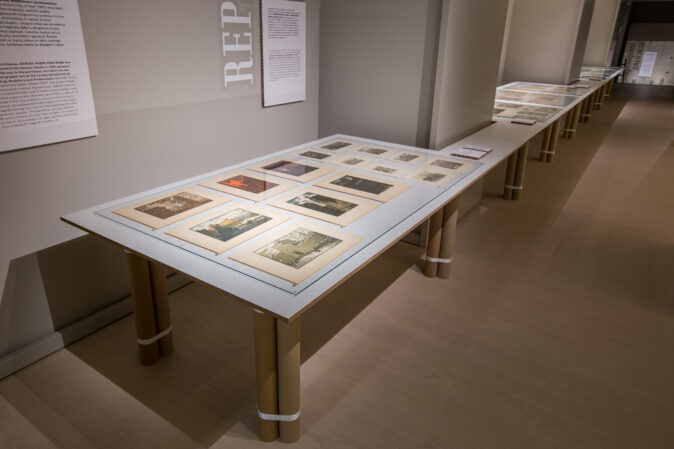
View of the exposition
